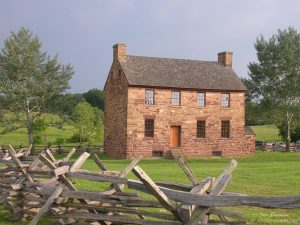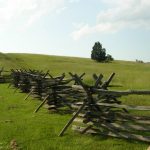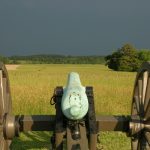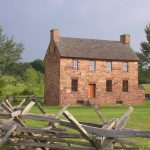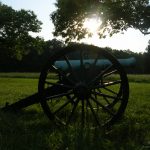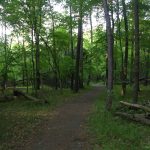 Manassas NBP, established in 1940, protects the site of two major Civil War battles near Washington D.C.
Manassas NBP, established in 1940, protects the site of two major Civil War battles near Washington D.C.
Visitor Rating (write your own review below)
ILNP Park Review
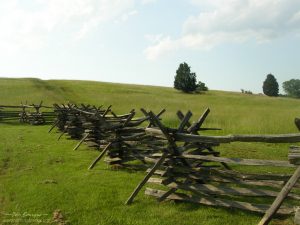
The battlefield is a landscape of fields and woods. This is looking towards Matthews Hill from the Stone House (June)
Our Visit. I visited Manassas NBP one evening in June while on a business trip to the D.C. area.
Our Weather. Warm (low 80s) with isolated thunderstorms
Overall Impression. Manassas NBP is situated in the middle of the D.C. suburban sprawl, but except for the traffic, the park offers an isolation appropriate for the significance of this place which makes it a great place to explore. The two battles fought here were known as First and Second Manassas in the South and First and Second Bull Run in the North. First Manassas was fought on July 21st, 1861 and was the first major land battle in the Civil War. It was here, with the defeat of the Union Army with their sights on Richmond, that the public first realized this would be a protracted war with many casualties. The Second Battle of Manassas was fought in late August 1962 and also resulted in a Confederate victory at the hands of Generals Stonewall Jackson and Longstreet.
Visiting. Plan on spending 1-2 hours at Manassas NBP. The best place to start is the Visitors Center where you can watch a short movie and get a good overview of both battles. Unfortunately, the Visitors Center hours are limited, so if you’re planning to go after a workday, you should read up on the battles before arriving. Once you leave the Visitors Center, you can explore many areas of the battlefield via the two major roads that crisscross the park or one of the many trails that take you through the battlefield’s most important locations. There is a 16-mile, 11-point driving tour that covers most of the spots, and each location has markers showing the Union and Confederate positions and highlighting the action for both battles (though the sequence is designed to follow the second battle).
The National Park Service has tried to maintain these grounds in a state close to conditions when the battles were fought, so there is a mix of fields, forests, fences, old buildings and cannon to help visitors imagine what it must have been like a century-and-a-half ago when tens of thousands of troops fought and bled on these fields. Take a few minutes and explore one of the trails that run throughout the park. These offer a bit more solitude than the parking lots, and they give you more perspective on why so much of the battles in this area were fought hand-to-hand.
Suggestions. If traveling in Spring or Summer, be sure to wear long pants or good insect repellent–between me and my traveling companion, we found three ticks on us, even though we didn’t stray from the marked path. Also, Highway US 29 is the major road in the park, and it’s two lanes swell with bumper-to-bumper traffic every afternoon from about 4:30-6:30 PM, so take this into account if you’re visiting during a weekday.
To learn more about the battles, click on the following links: First Bull Run, Second Bull Run
Nearby Towns Manassas, Fairfax, Chantilly (Virginia), Washington, D.C.
Other Nearby Attractions Washington D.C., National Mall, Shenandoah NP
Official NPS Website Manassas NBP
- The battlefield is a landscape of fields and woods. This is looking towards Matthews Hill from the Stone House (June)
- This cannon marks the line of Union artillery atop Matthews Hill in the Second Battle of Manassas. The foreboding sky is the remnants of a recently departed thunderstorm (June)
- The Stone House is right in the middle of the park. It served as a tavern before the war (June)
- A Confederate cannon stands vigil at Battery Heights near Manassas (June)
- The parking lot near Matthews Hill offers a short hike through the artillery in the fields and the nearby woods. It is in places like this that Union and Confederate soldiers engaged in close combat–it was just too difficult to see far enough to keep the enemy at a distance (June)
Write Your Own Review

